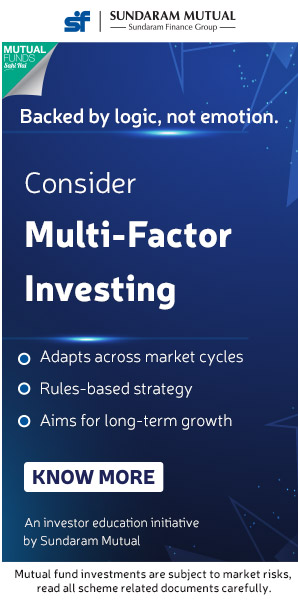Financial Glossary starting with Alphabet M
-
M1 and M3
Let's say you are extremely hungry. You go to the nearest restaurant. What is it that you would order when you are in such a state? Perhaps you would ask what can be prepared quickly because your hunger clearly seems to be getting the better of you. You would not order Biryani since it needs to be cooked slowly for it to taste really well.
But if something is needed immediately, the best option is sandwiches, snacks etc.
Let's say we term the quickly available snack items collectively as F1 and all food items in the menu that the restaurant serves (including those that can be served quickly) as F3.
In short, Quick food items = F1. All food items in the Menu (including F1) = F3
Now if we were to replace the Food by Money the context changes as in Money which is easily available like the sandwiches, snacks etc can be termed M1 while all the money that is there which includes M1 is then termed M3.
Let's analyze when money can be easily made available (M1).
M1 is the money in your pocket or in your cupboard or in your savings bank account against which you can issue a cheque and buy goods and services immediately without resorting to any planning whatsoever. We also refer to this money as highly liquid currency.
Similarly the money which is readily available (M1) plus that which is parked as time deposits in the banks is together termed as M3.
While M1 is liquid, the bank deposits are not easily usable because one would have to break the deposits first. Hence in comparison to M1, bank deposits can be seen as less liquid currency.
So M3 = (M1 + Time deposits with the bank). M3 is the broadest measure of money; it is used by economists to estimate the entire supply of money within an economy at any given point of time. (Source: Tata Mutual fund) -
Mutual Fund
A Mutual Fund (in Indian Context) is a body corporate registered with SEBI (Securities Exchange Board of India) that pools money from individuals/corporate investors andInvests the same in a variety of different financial instruments or securities such as equity shares, Government securities, Bonds, debentures etc.
Mutual funds can thus be considered as financial intermediaries in the investment business that collect funds from the public and invest on behalf of the investors. Mutual funds issue units to the investors. The appreciation of the portfolio or securities in which the mutual fund has invested the money leads to an appreciation in the value of the price of the units held by investors (unit holder). Each unit holder participates proportionally in the gain or loss of the fund.
“Thus, a mutual fund is nothing but a pool of money generated by individual investors to buy shares of many companies. As an individual it would take a lot of money to buy shares of 50 to 60 companies but for a mutual fund it becomes easy to buy shares collectively and then share it with the investors in the proportion of their investment. Moreover the people who manage the mutual fund are qualified people and understand the nuances of this job.”
The investment objectives outlined by a Mutual Fund in its prospectus are binding on the Mutual Fund scheme (fund). The investment objectives specify the class of securities a Mutual Fund can invest in. Mutual Funds invest in various asset classes like equity, bonds, debentures, commercial paper and government securities. The schemes offered by mutual funds vary from fund to fund. Some are pure equity schemes; others are a mix of equity and bonds. Investors are also given the option of getting dividends, which aredeclared periodically by the mutual fund, or Reinvest the Dividend by getting additional units in lieu of the amount to participate only in the capital appreciation (Growth) of the scheme.
Mutual fund units can typically be purchased or redeemed as needed at the fund\'s current net asset value (NAV) per unit. -
Market Capitalisation
The market value of a quoted company, which is calculated by multiplying its current share price (market price) by the number of shares in issue is called as market capitalization.
Example – The Market Capitalisation of Reliance Industries as on 29th Nov’13 is Rs. Crores 275,607 Crores (3230.65 Million shares multiplied by market rate of Rs. 853.10 each share (BSE price as on 29/11/13) -
Modified Duration
Let’s say I am a stockist of winter clothes such as sweaters and mufflers. In anticipation of a good winter, I have stocked clothes in excess. My biggest concern is whether I will be able to sell all these before the onset of summer.
Let’s say if the summer steps in earlier than expected, then what do I do? Naturally to clear the stock I will have to lower its price.
Contrary, if for some reason the winter gets more severe and prolonged, then what could happen? In such a situation I will charge a premium for the goods that I have in stock and since I have a large supply, I would therefore make more money.
Thus, the behavior of an external factor seems to be having a major impact on the prices I charge in the market.
Modified Duration by definition expresses the sensitivity of the price of a bond to a change in interest rate. The change in interest rate can be linked with the season change as explained in the previous example. So if the modified duration of a debt fund is less, it is similar to having less stock so that even if the interest rates were to change, the impact on price would be less.
On the other hand, if the modified duration is higher, it would be like having excess stock so that if interest rates were to change, the impact on prices would be large. So higher the modified duration, higher is the risk of price fluctuation and lower the modified duration, the lower would be the price fluctuation.
Basically, the price of a bond and the interest rate have inverse relationship, i.e. if the interest rates rise, the price of the bond would fall and vice versa.
The modified duration explains the extent of rise or fall in bond price, given a change in interest rate.
Mathematically, CHANGE IN PRICE OF A BOND IS THE ARITHMETIC PRODUCT OF MODIFIED DURATION OF THE BOND AND CHANGE IN EXTERNAL INTEREST RATE.
So, if a Fund Manager feels that the interest rates are going to rise (similar to expecting the summer setting in sooner than expected), he would reduce the modified duration of the portfolio. Alternatively, if he feels that the interest rates are to fall (similar to expecting the winter to last longer), he will maintain a higher duration and benefit from the fall in interest rates.
Having understood the concept let us now use modified duration to calculate the change in price of a bond for a given change in interest rate.
CHANGE IN BOND PRICE = - MODIFIED DURATION X % CHANGE IN YIELD (The negative sign in this equation indicates inverse relationship between change in yield and change in bond price)
For example, if the modified duration of a bond is 5 and yield is expected to fall by 2% in a year, expected change in price of the bond (on account of change in yield) can be calculated as
CHANGE IN BOND PRICE = - 5 * -2% = + 10%.
Similarly, if the modified duration of a bond is 5 and yield is expected to rise by 2% in a year, expected change in price of the bond can be calculated as
CHANGE IN BOND PRICE = - 5 * 2% = - 10%.
Some key points about modified duration:
1. A “Bond” with a lower “modified duration” implies that the “returns” are more from accrual income than from capital gains.
2. A “Bond” with a higher “modified duration” implies that the “returns” are more from capital gains than from accrual income.
3. Maturity remaining the same a high coupon yielding bond would have a lower duration and hence be less sensitive to changes in external interest rates as compared to a low coupon yielding bond. (Source: Tata Mutual Fund) -
Margin Money in Derivatives
‘Margin Money’ is a term associated with derivative instrument transactions.
Let’s say there are three parties A (Buyer), B (Seller) and C (Broker). A is interested in buying a futures contract for Rs. 100 as he thinks its price would go up by the settlement date. B, on the other hand, wants to sell the futures contract for Rs. 100 as he thinks its price will go down by the settlement date. C is the broker who will be executing the deal on behalf of investors A & B.
Now, as we have explained in our earlier lessons, derivative trading is about taking a ‘call’ on the upward and downward movement of the scrip. Hence the subject in question is the movement of price (upward or down ward) and not the absolute or actual price of the total contract.
Therefore, the Stock Exchange has to be hedged by investors (A & B) to the extent of the expected margin of loss that the investor might incur. Thus, the Broker acts as a mediator between the Exchange & the Investors.
For example in our case, where the cost of futures is Rs 100, in all likelihood its value would go up or down by say Rs 10 either way by the settlement date based on expected volatility which is calculated mathematically.
Hence the margin money sought by the Exchange through the broker from either party would be 10% of the total value (Rs.10 in the given example). Please note that irrespective of price movement, both the investors need to maintain 10% of the margin.
Now let’s say by the settlement date, the scrip would be valued at Rs. 108. This means ‘A’ would have made a profit of Rs 8 while ‘B’ would have incurred a loss of Rs. 8.
The broker hence credits the investor ‘A’s account by Rs. 8 along with the margin money of Rs. 10. Hence in total ‘A’ receives Rs 18.
On the other hand ‘B’ who has incurred a loss will debit Rs. 8 from his margin money which was with the broker and the remaining Rs. 2 will be transferred to the investor’s account.
Therefore the “funding” that goes to the broker to execute derivative deals is called “Margin Funding” or “Margin Money”. Just to appreciate that in case of buy/sell of actual stocks (spot trading) instead of derivatives trading, the broker would have needed enough funds to cover the entire cost of the scrip in order to execute a spot deal.
In the case of derivative trading, he only needs funds to cover up the margin movements. (Source: Tata Mutual Fund) -
Mutual Fund Vs. Hedge Fund
Hedge funds are like mutual funds in some ways. Investment professionals in a hedge fund pool in money from investors to be managed - exactly like the mutual funds do. And, subject to some minor restrictions, investors in hedge funds can withdraw their money as they can in a mutual fund. Nothing else is similar. Let us understand the differences.
Difference 1 - Hedge Funds focus on absolute returns. Mutual Funds focus on relative returns. Returns should be higher than benchmark
Difference 2 - Hedge Funds can invest in any asset class - stocks, bonds, commodities, real estate, private partnerships, - or exotic debt products like packaged sub-prime mortgages. Mutual Funds work within a risk controlled and compliance framework set up by the regulator. Hence very risky asset classes are prohibited for investment.
Difference 3 - Hedge Funds can borrow to bet bigger and enhance returns. Mutual Funds can borrow – but within SEBI guidelines
Difference 4 - Hedge Funds can run highly concentrated portfolios. Mutual Funds, the objective is to protect investors’ investment and hence diversification is the key principle.
Difference 5 - Hedge Funds meant for those who are already rich. Hedge funds are open only to 'accredited investors' defined as those with net worth of more than $1.5 million, or income in excess of $200,000 in each of the past two years. The good ones demand $1 million or more of investment. Mutual Funds meant for people at large providing them with an option of building wealth through equity and debt investments. Mutual Funds allow even small investors to participate.
Difference 6 - Hedge Funds work on 2/20 basis which means they charge 2% a year by way of management fees and 20% of the net profit. They do not share in losses. Mutual Funds can charge 1.25% on the first 100 crores of the AUM managed. Annual expenses can go upto 2.25% to 2.50%.
Difference 7 - Hedge Funds are virtually unregulated. Mutual Funds are heavily regulated because investor safety is the most important requirement
Difference 8 - Hedge Funds cannot market themselves publicly. Mutual Funds are sold as products to enhance wealth. (Source: Tata Mutual Fund) -
Mark to Market
Mark-to-market Accounting - Accounting rules are the favourite whipping boys of the financial market during bad times. These days too, it is the presence of what is called ‘the mark-to-market accounting rule’ that is being touted as one of the culprits behind much of the write-downs seen in the financial market. However, before forming any opinion let’s try to understand how the mark-to-market accounting rule works.
Mark-to-market is a very simple and straightforward accounting rule that prescribes a method for finding out the fair value for all kinds of financial assets.
The list of financial assets, as you know, is fairly long—all your stocks, bonds, options, swaps etc. can be called financial assets.
How, you may wonder, does the mark-to-market accounting rule apply to so many different kinds of financial assets? Simply put, the mark to-market accounting rule relies on the use of the current market price of your financial assets to arrive at their fair value.
So if you are holding a stock that is currently trading at Rs.100, then as per the mark-to-market accounting rule, the fair value of your stock is Rs.100.
You may have actually acquired the stock by paying Rs.200 and expect that one day the same stock would trade at a much higher price. But in the realm of the mark-to-market accounting rule, future expectations do not play a role.
Therefore, the worth of your asset is always determined by the price at which you can currently sell it in the market. There is no need to look at any other statistic like future earnings, growth potential or any other fact or fiction surrounding your financial asset. Even a blindfolded man can know the fair value of any financial asset by just using the current market price as the yardstick.
However, many skeptics believe that while this may sound good in theory, in reality the free play of market forces may not always reflect the correct price of a financial asset. Sometimes the scale of the market may excessively tip to one side or the other, moving prices away from where they should be.
For instance, distress sales hardly give any chance of selling your asset at the right price. In the worst case, as the experience of the subprime crisis showed, the financial market itself may freeze completely, leaving you with assets for which there are absolutely no takers.
In such situations, the mark-to-market accounting rule may become a messenger of death even when your financial assets are generating some income.
Well, we can’t accept the mark-to-market accounting rule as the last word on valuation of financial assets. Neither can we completely dump the mark-to-market accounting rule. We definitely need to strike a balance. The main attraction of the mark-to-market accounting rule lies in its simplicity and objectivity.
The mark-to-market accounting rule compels us to look at the real picture.
To Sum Up, Mark-to-market is a very simple and straightforward accounting rule that relies on the use of the current market price of your financial assets to arrive at their fair value.
Many skeptics believe that the mark-to-market rule does not reflect the effect of market forces on the correct price. But, barring extreme situations, the mark-to-market accounting rule still has the potential to become the best friend of our financial market. (Source: Tata Mutual Fund)










